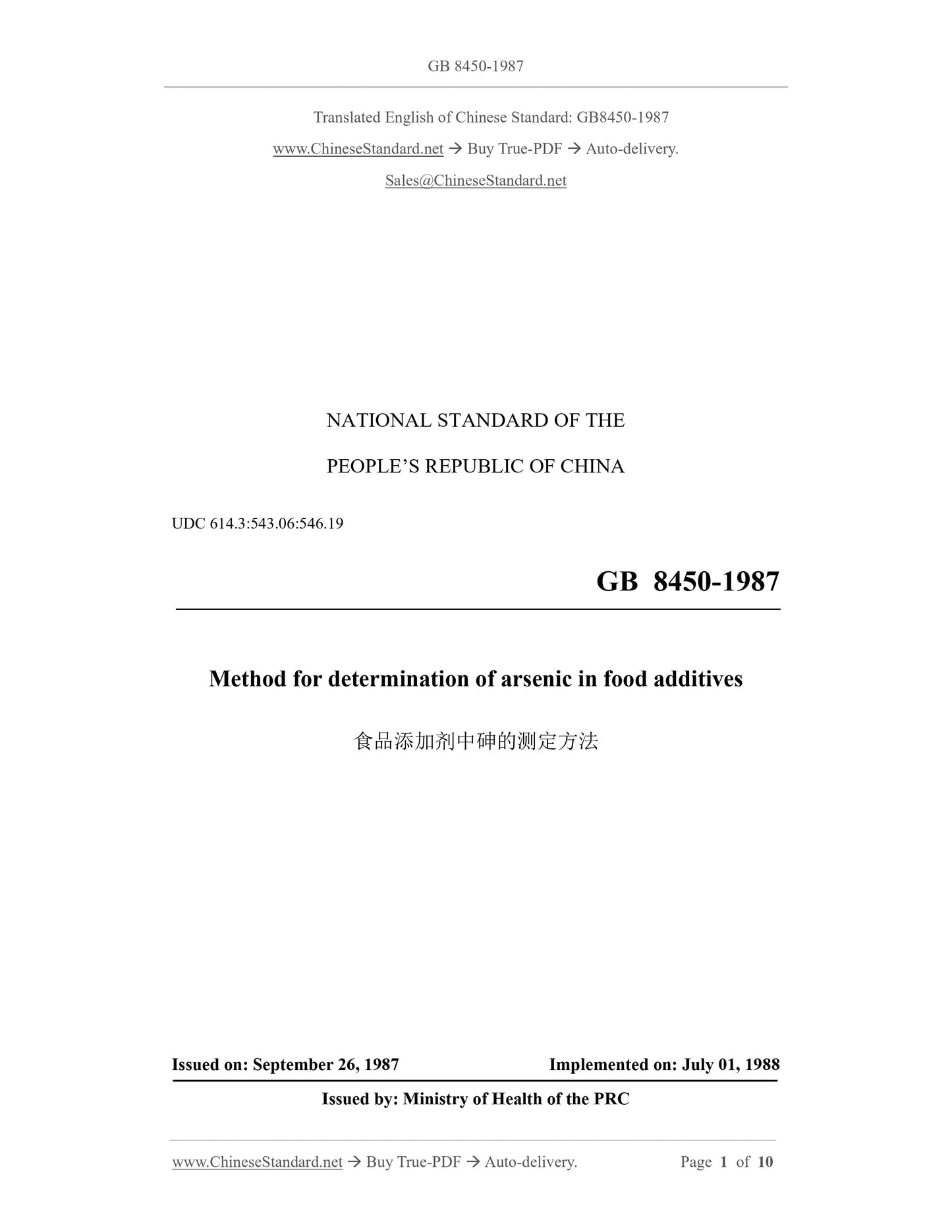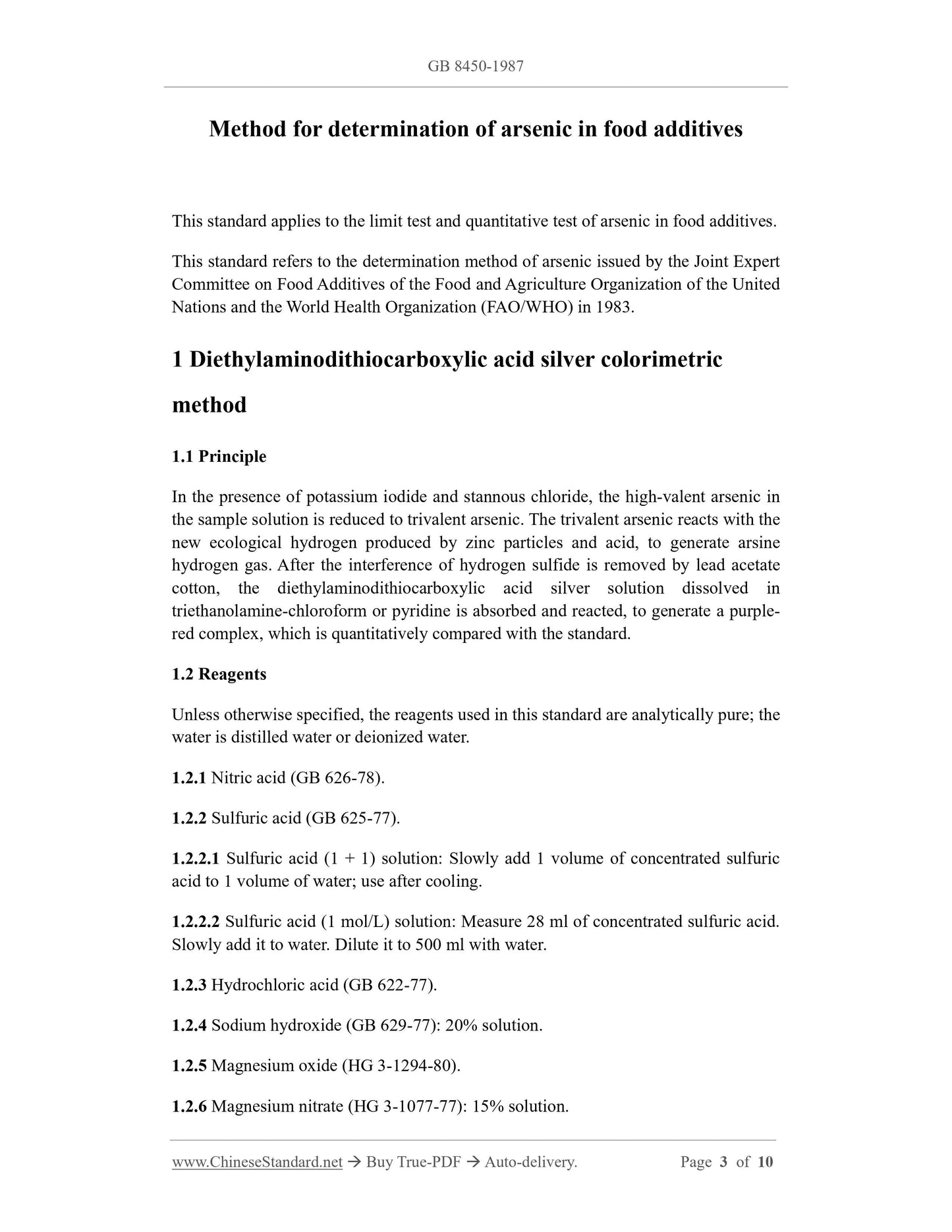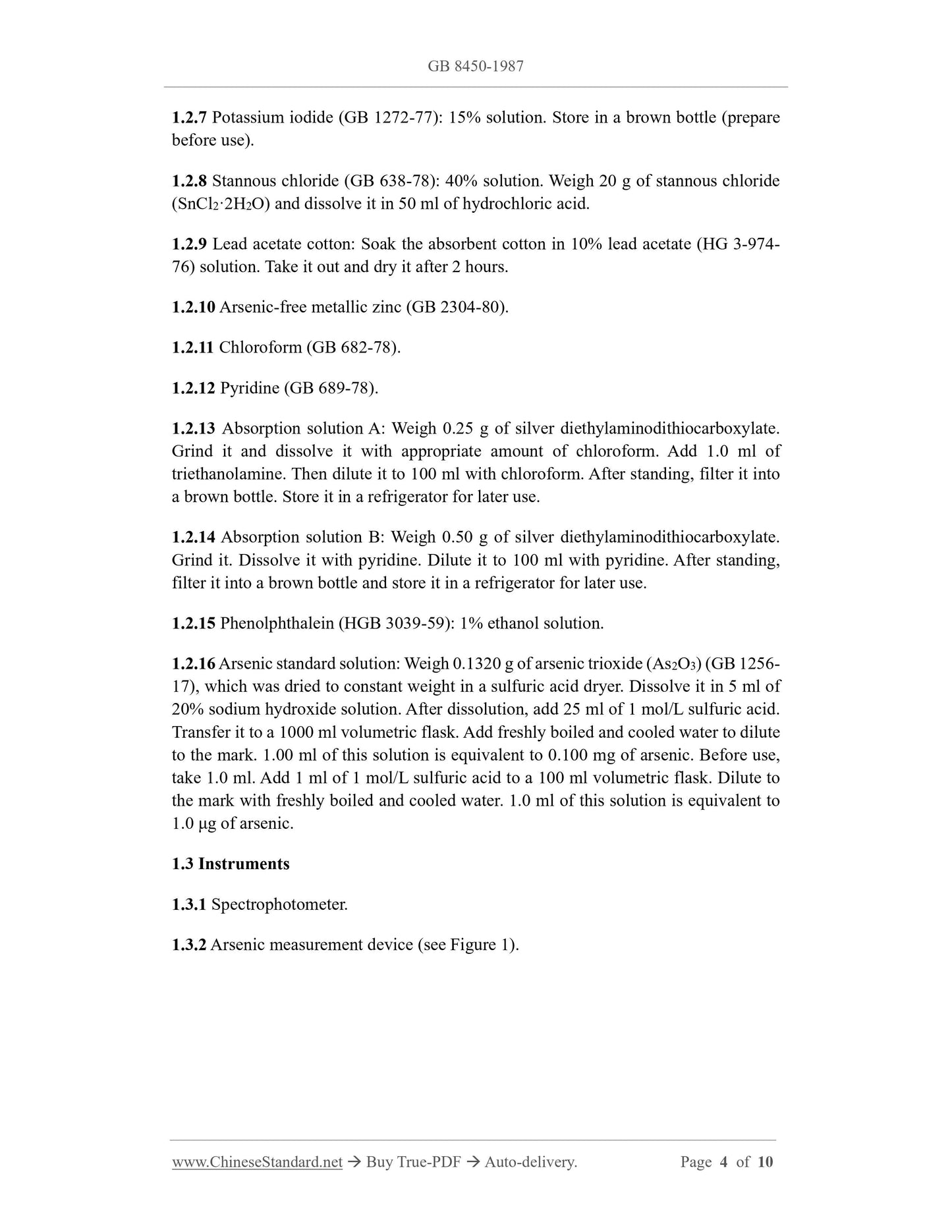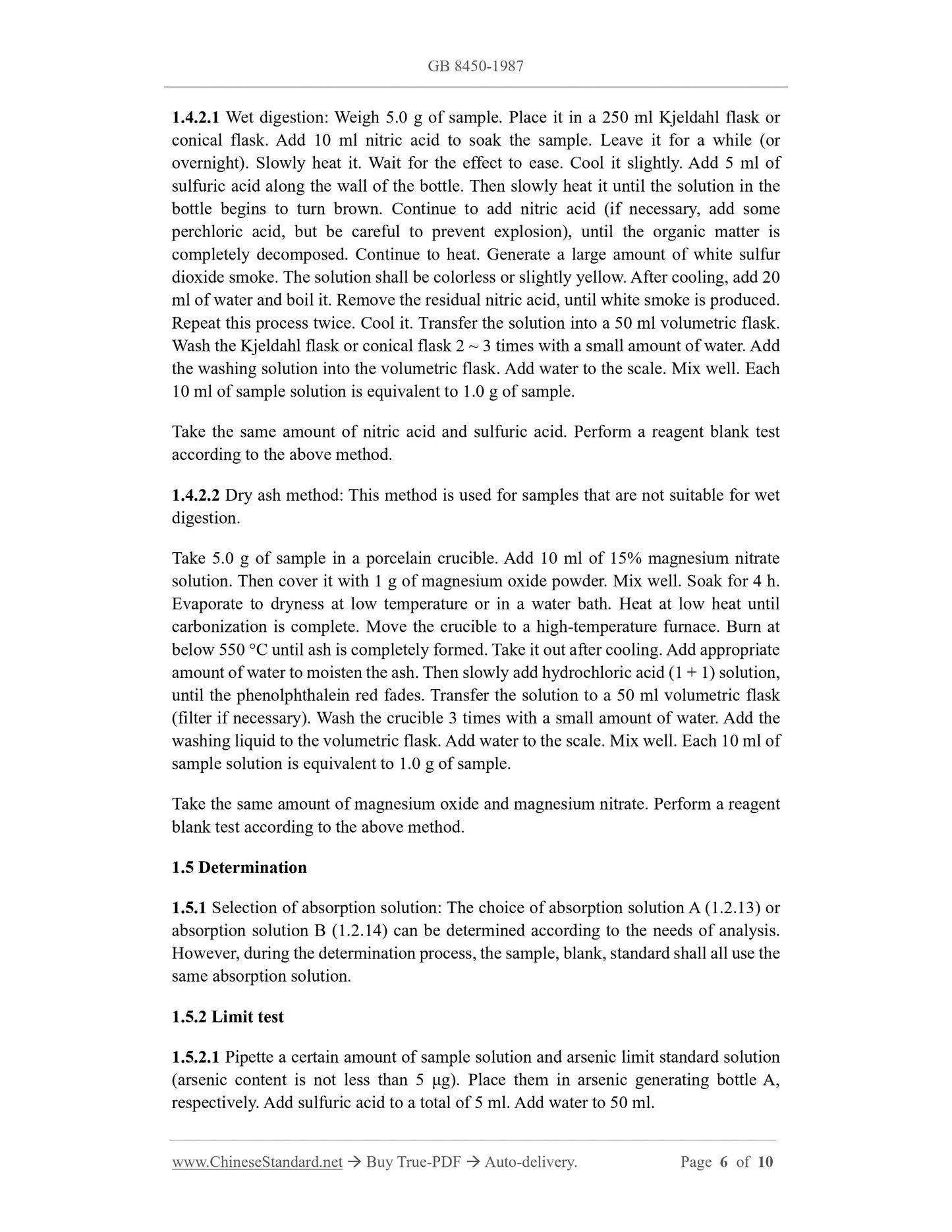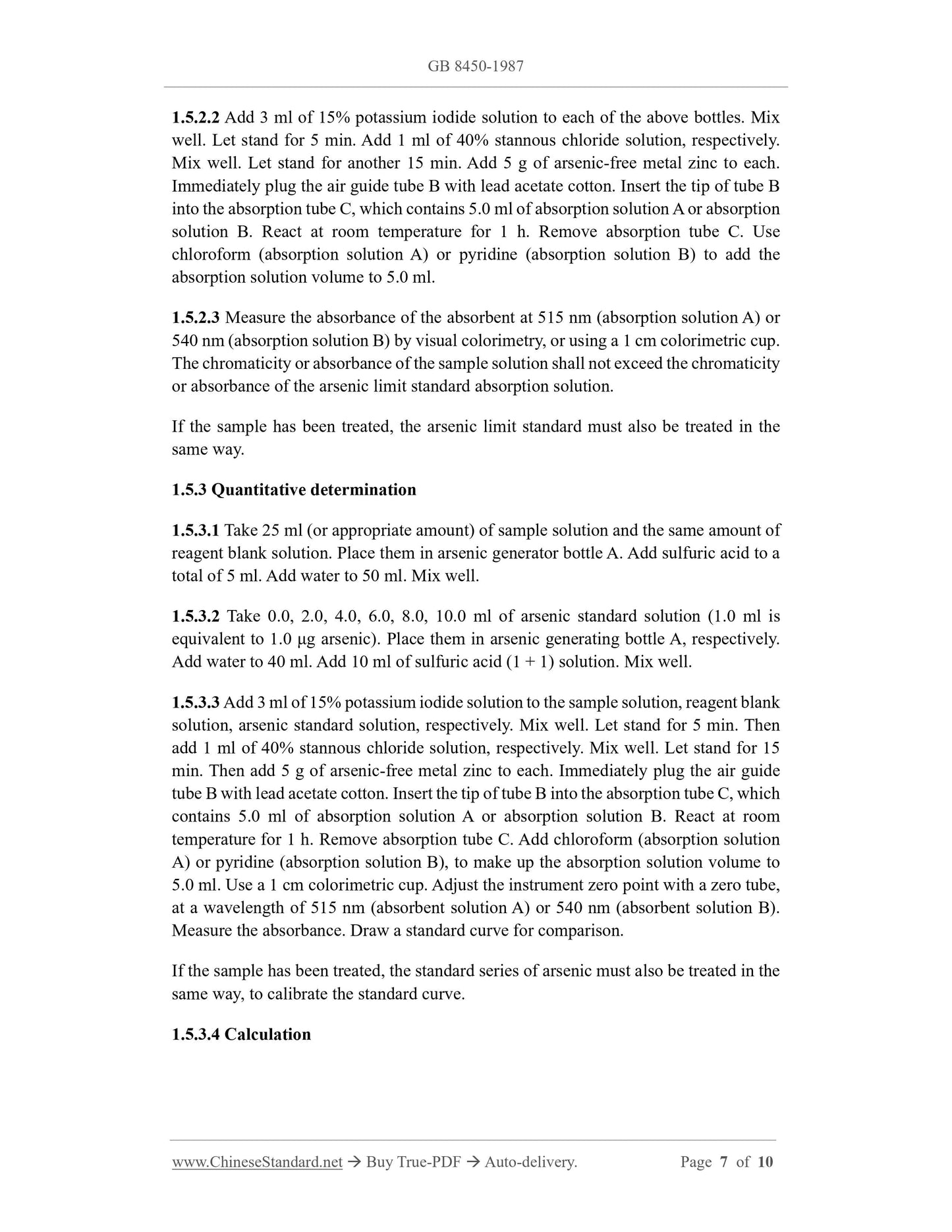1
/
of
6
www.ChineseStandard.us -- Field Test Asia Pte. Ltd.
GB/T 8450-1987 English PDF (GB/T8450-1987)
GB/T 8450-1987 English PDF (GB/T8450-1987)
Regular price
$190.00
Regular price
Sale price
$190.00
Unit price
/
per
Shipping calculated at checkout.
Couldn't load pickup availability
GB/T 8450-1987: Method for determination of arsenic in food additives
Delivery: 9 seconds. Download (and Email) true-PDF + Invoice.Get Quotation: Click GB/T 8450-1987 (Self-service in 1-minute)
Newer / historical versions: GB/T 8450-1987
Preview True-PDF
Scope
method1.1 Principle
In the presence of potassium iodide and stannous chloride, the high-valent arsenic in
the sample solution is reduced to trivalent arsenic. The trivalent arsenic reacts with the
new ecological hydrogen produced by zinc particles and acid, to generate arsine
hydrogen gas. After the interference of hydrogen sulfide is removed by lead acetate
cotton, the diethylaminodithiocarboxylic acid silver solution dissolved in
triethanolamine-chloroform or pyridine is absorbed and reacted, to generate a purple-
red complex, which is quantitatively compared with the standard.
1.2 Reagents
Unless otherwise specified, the reagents used in this standard are analytically pure; the
water is distilled water or deionized water.
1.2.1 Nitric acid (GB 626-78).
1.2.2 Sulfuric acid (GB 625-77).
1.2.2.1 Sulfuric acid (1 + 1) solution: Slowly add 1 volume of concentrated sulfuric
acid to 1 volume of water; use after cooling.
1.2.2.2 Sulfuric acid (1 mol/L) solution: Measure 28 ml of concentrated sulfuric acid.
Slowly add it to water. Dilute it to 500 ml with water.
1.2.3 Hydrochloric acid (GB 622-77).
1.2.4 Sodium hydroxide (GB 629-77): 20% solution.
1.2.5 Magnesium oxide (HG 3-1294-80).
1.2.6 Magnesium nitrate (HG 3-1077-77): 15% solution.
1.2.7 Potassium iodide (GB 1272-77): 15% solution. Store in a brown bottle (prepare
before use).
1.2.8 Stannous chloride (GB 638-78): 40% solution. Weigh 20 g of stannous chloride
(SnCl2·2H2O) and dissolve it in 50 ml of hydrochloric acid.
1.2.9 Lead acetate cotton: Soak the absorbent cotton in 10% lead acetate (HG 3-974-
76) solution. Take it out and dry it after 2 hours.
1.2.10 Arsenic-free metallic zinc (GB 2304-80).
1.2.11 Chloroform (GB 682-78).
1.2.12 Pyridine (GB 689-78).
1.2.13 Absorption solution A: Weigh 0.25 g of silver diethylaminodithiocarboxylate.
Grind it and dissolve it with appropriate amount of chloroform. Add 1.0 ml of
triethanolamine. Then dilute it to 100 ml with chloroform. After standing, filter it into
a brown bottle. Store it in a refrigerator for later use.
1.2.14 Absorption solution B: Weigh 0.50 g of silver diethylaminodithiocarboxylate.
Grind it. Dissolve it with pyridine. Dilute it to 100 ml with pyridine. After standing,
filter it into a brown bottle and store it in a refrigerator for later use.
1.2.15 Phenolphthalein (HGB 3039-59): 1% ethanol solution.
1.2.16 Arsenic standard solution: Weigh 0.1320 g of arsenic trioxide (As2O3) (GB 1256-
17), which was dried to constant weight in a sulfuric acid dryer. Dissolve it in 5 ml of
20% sodium hydroxide solution. After dissolution, add 25 ml of 1 mol/L sulfuric acid.
Transfer it to a 1000 ml volumetric flask. Add freshly boiled and cooled water to dilute
to the mark. 1.00 ml of this solution is equivalent to 0.100 mg of arsenic. Before use,
take 1.0 ml. Add 1 ml of 1 mol/L sulfuric acid to a 100 ml volumetric flask. Dilute to
the mark with freshly boiled and cooled water. 1.0 ml of this solution is equivalent to
1.0 μg of arsenic.
1.3 Instruments
1.3.1 Spectrophotometer.
1.3.2 Arsenic measurement device (see Figure 1).
1.4.2.1 Wet digestion: Weigh 5.0 g of sample. Place it in a 250 ml Kjeldahl flask or
conical flask. Add 10 ml nitric acid to soak the sample. Leave it for a while (or
overnight). Slowly heat it. Wait for the effect to ease. Cool it slightly. Add 5 ml of
sulfuric acid along the wall of the bottle. Then slowly heat it until the solution in the
bottle begins to turn brown. Continue to add nitric acid (if necessary, add some
perchloric acid, but be careful to prevent explosion), until the organic matter is
completely decomposed. Continue to heat. Generate a large amount of white sulfur
dioxide smoke. The solution shall be colorless or slightly yellow. After cooling, add 20
ml of water and boil it. Remove the residual nitric acid, until white smoke is produced.
Repeat this process twice. Cool it. Transfer the solution into a 50 ml volumetric flask.
Wash the Kjeldahl flask or conical flask 2 ~ 3 times with a small amount of water. Add
the washing solution into the volumetric flask. Add water to the scale. Mix well. Each
10 ml of sample solution is equivalent to 1.0 g of sample.
Take the same amount of nitric acid and sulfuric acid. Perform a reagent blank test
according to the above method.
1.4.2.2 Dry ash method: This method is used for samples that are not suitable for wet
digestion.
Take 5.0 g of sample in a porcelain crucible. Add 10 ml of 15% magnesium nitrate
solution. Then cover it with 1 g of magnesium oxide powder. Mix well. Soak for 4 h.
Evaporate to dryness at low temperature or in a water bath. Heat at low heat until
carbonization is complete. Move the crucible to a high-temperature furnace. Burn at
below 550 °C until ash is completely formed. Take it out after cooling. Add appropriate
amount of water to moisten the ash. Then slowly add hydrochloric acid (1 + 1) solution,
until the phenolphthalein red fades. Transfer the solution to a 50 ml volumetric flask
(filter if necessary). Wash the crucible 3 times with a small amount of water. Add the
washing liquid to the volumetric flask. Add water to the scale. Mix well. Each 10 ml of
sample solution is equivalent to 1.0 g of sample.
Take the same amount of magnesium oxide and magnesium nitrate. Perform a reagent
blank test according to the above method.
1.5 Determination
1.5.1 Selection of absorption solution: The choice of absorption solution A (1.2.13) or
absorption solution B (1.2.14) can be determined according to the needs of analysis.
However, during the determination process, the sample, blank, standard shall all use the
same absorption solution.
1.5.2 Limit test
1.5.2.1 Pipette a certain amount of sample solution and arsenic limit standard solution
(arsenic content is not less than 5 μg). Place them in arsenic generating bottle A,
respectively. Add sulfuric acid to a total of 5 ml. Add water to 50 ml.
1.5.2.2 Add 3 ml of 15% potassium iodide solution to each of the above bottles. Mix
well. Let stand for 5 min. Add 1 ml of 40% stannous chloride solution, respectively.
Mix well. Let stand for another 15 min. Add 5 g of arsenic-free metal zinc to each.
Immediately plug the air guide tube B with lead acetate cotton. Insert the tip of tube B
into the absorption tube C, which contains 5.0 ml of absorption solution A or absorption
solution B. React at room temperature for 1 h. Remove absorption tube C. Use
chloroform (absorption solution A) or pyridine (absorption solution B) to add the
absorption solution volume to 5.0 ml.
1.5.2.3 Measure the absorbance of the absorbent at 515 nm (absorption solution A) or
540 nm (absorption solution B) by visual colorimetry, or using a 1 cm colorimetric cup.
The chromaticity or absorbance of the sample solution shall not exceed the chromaticity
or absorbance of the arsenic limit standard absorption solution.
If the sample has been treated, the arsenic limit standard must also be treated in the
same way.
1.5.3 Quantitative determination
1.5.3.1 Take 25 ml (or appropriate amount) of sample solution and the same amount of
reagent blank solution. Place them in arsenic generator bottle A. Add sulfuric acid to a
total of 5 ml. Add water to 50 ml. Mix well.
1.5.3.2 Take 0.0, 2.0, 4.0, 6.0, 8.0, 10.0 ml of arsenic standard solution (1.0 ml is
equivalent to 1.0 μg arsenic). Place them in arsenic generating bottle A, respectively.
Add water to 40 ml. Add 10 ml of sulfuric acid (1 + 1) solution. Mix well.
1.5.3.3 Add 3 ml of 15% potassium iodide solution to the sample solution, reagent blank
solution, arsenic standard solution, respectively. Mix well. Let stand for 5 min. Then
add 1 ml of 40% stannous chloride solution, respectively. Mix well. Let stand for 15
min. Then add 5 g of arsenic-free metal zinc to each. Immediately plug the air guide
tube B with lead acetate cotton. Insert the tip of tube B into the absorption tube C, which
contains 5.0 ml of absorption solution A or absorption solution B. React at room
temperature for 1 h. Remove absorption tube C. Add chloroform (absorption solution
A) or pyridine (absorption solution B), to make up the absorption solution volume to
5.0 ml. Use a 1 cm colorimetric cup. Adjust the instrument zero point with a zero tube,
at a wavelength of 515 nm (absorbent solution A) or 540 nm (absorbent solution B).
Measure the absorbance. Draw a standard curve for comparison.
If the sample has been treated, the standard series of arsenic must also be treated in the
same way, to calibrate the standard curve.
1.5.3.4 Calculation
Basic Data
| Standard ID | GB/T 8450-1987 (GB/T8450-1987) |
| Description (Translated English) | Method for determination of arsenic in food additives |
| Sector / Industry | National Standard (Recommended) |
| Classification of Chinese Standard | C54 |
| Word Count Estimation | 5,587 |
| Date of Issue | 9/22/1987 |
| Date of Implementation | 5/1/1988 |
Share
